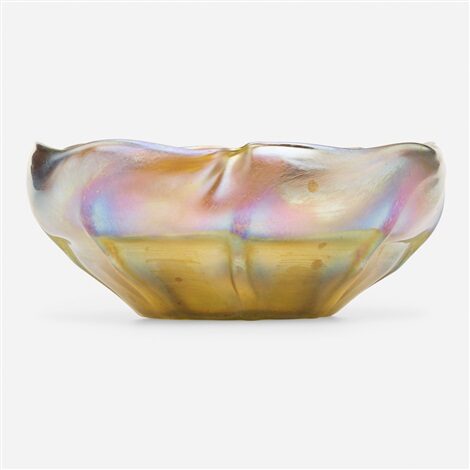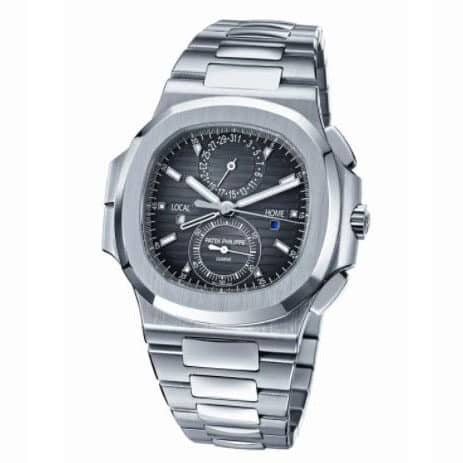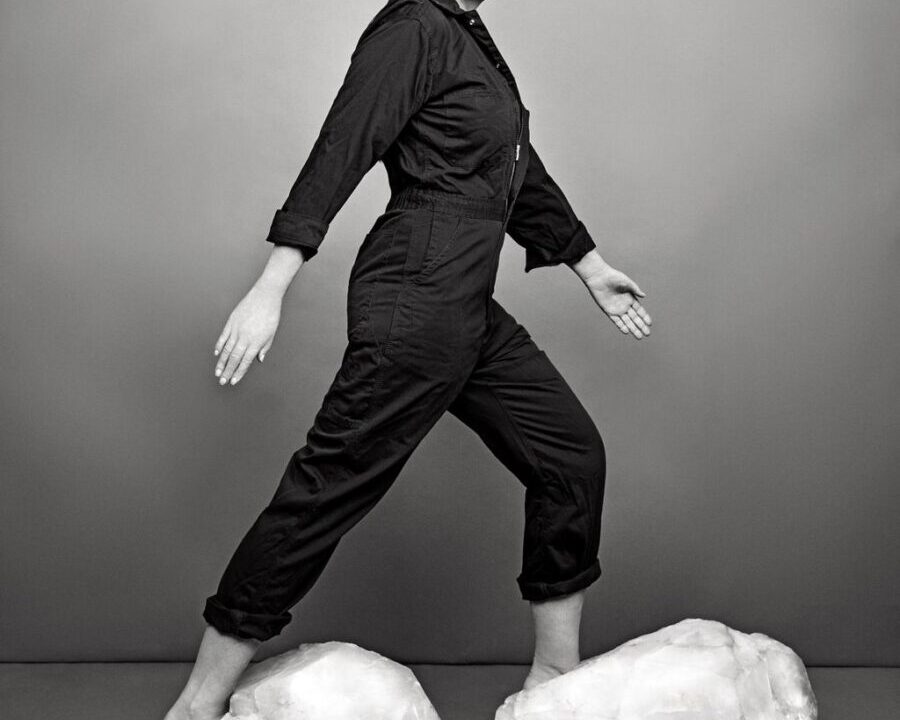Tiffany Studios is the best-known of artist Louis Comfort Tiffany’s vast enterprise operating under various names, such as Tiffany Glass Company, Tiffany Glass and Decorating Company, Allied Arts, and Tiffany & Company. Louis Tiffany was the son of Charles Lewis Tiffany, founder of the successful and influential jewelry firm, Tiffany & Company.
Louis Comfort Tiffany
Louis was the president and art director of Tiffany Studios, the primary figure directing all production, both technically and artistically. Tiffany’s career spanned the 1870s through the 1920s, embracing virtually every artistic and decorative medium: leaded-glass windows, enamels, jewelry, mosaics, glass, pottery, metalwork, interiors, and the famous Tiffany lamps. Tiffany began as a painter but soon turned his attention to decorative arts and interiors, while never abandoning painting. Tiffany’s earliest jewelry designs were exhibited at the 1904 Louisiana Purchase Exposition in St. Louis. While Tiffany Studios was known for its enamels, pottery, and Favrile glass vessels, the studio’s jewelry garnered wide acclaim and favorable press by the period’s art critics. Designs inspired by nature, the use of semiprecious stones and enamel, and exquisite craftsmanship bestowed on Tiffany’s unique jewelry pieces the prestige of fine art.
Lighting and Lamps
Growing out of an interest in interior decorating, Tiffany Studios turned toward lighting and lamps. Beautiful craftsmanship, organic forms often drawn from nature, and the masterful use of color distinguish Tiffany lamps from those of other lamp makers. A tireless innovator, Tiffany explored new glassmaking methods, ultimately pioneering and patenting Favrile glass, a richly hued, iridescent glass that became a trademark of Tiffany Studios. Tiffany opened a glass factory in Corona, New York, determined to provide designs that improved the quality of contemporary glass. The Tiffany Glass Company was incorporated in 1885; in 1902, it became known as Tiffany Studios.
A New Way of Using Glass
In the beginning, Tiffany used cheap jelly jars and bottles because they had mineral impurities lacking in finer glass. Tiffany used opalescent glass in a variety of colors and textures to create a unique style of stained glass, acquiring Stanford Bray’s patent for the “copper foil” technique. By edging each piece of cut glass in copper foil and soldering it all together to create windows and lamps, Tiffany Studios made possible a level of detail not previously known. This technique was quite different from the then-current method of glasswork: painting in enamels or glass paint on colorless glass and setting the glass pieces in lead channels to create the finished design.
Leaded Glass Art
Of all Tiffany’s artistic endeavors, leaded glass brought the greatest recognition. Tiffany and early rival John La Farge revolutionized the look of stained glass by experimenting with new types of glass to achieve a more varied palette with richer hues and greater density. Tiffany trademarked the word Favrile, recalling the Old English word fabrile (hand-wrought) to apply to all the glass, enamel, and pottery produced by Tiffany Studios. The term signified high-quality glass that was uniquely handmade. Colored throughout with variegated shades of the same or different hues, Tiffany’s Favrile glass was an ideal choice for pictorial details because of its tonal gradations, lines, textures, and density. Much of Tiffany Studios’ production consisted of stained glass windows and Tiffany lamps that were handmade, the reason they are still cherished today as unique works of art.
Mosaics
Mosaics were a natural progression and extension of Tiffany’s work in leaded glass. Glass mosaics were used in interior settings, initially in church settings and fireplace surrounds, but then developed into full artistic works. At the turn of the century, Tiffany introduced enamel work made in Tiffany Studios’ unique style. In this technique, layers of translucent enamel in wide-ranging naturalistically shaded hues were applied to a luminous surface, usually gilt, and finished with an iridescent coating that provided a rainbow luster.
Glasshouse Factory Established in 1893
At its peak, Louis Tiffany’s glasshouse factory, Stourbridge Glass Factory, later called Tiffany Glass Furnaces in Corona, Queens, New York, employed more than 300 artisans to translate the studios’ visions into the beautiful blown-glass vases, leaded-glass windows, and lamps, pottery, and jewelry that captivated an era. Tiffany developed a method whereby different colors were blended together in the molten state, achieving subtle effects of shading and texture.
Tiffany Studios Tradition
Tiffany Studios was designed in the historical tradition of studios that produced works under the name of an established artist with a specific design theory—one based on the artist’s own ideals but under which designers were encouraged to interpret creatively. Tiffany maintained a design file to provide inspiration for the designers, securing the unity and quality of overall production. Under his tutelage, teams of designers and craftspeople translated the all-encompassing vision into the beautiful objects—blown-glass vases, leaded-glass windows, and lamps, pottery, and jewelry—that captivated an era.
Women Workers
Many of Tiffany’s workers were women, sometimes referred to as the “Tiffany Girls,” who played a large role in designing many of the floral patterns on the famous Tiffany lamps. The employment of women was innovative enough that it warranted coverage in contemporary publications. One woman, Clara Driscoll, designed many lamps for Tiffany, assisted in the production of windows, and was involved in management and business decisions in the lamps and fancy goods department. Over time, the lamps became the primary domain for the women working under the tutelage of Clara Driscoll. Their designs included beautiful floral and nature-based patterns, and their smaller hands and dexterity were particularly suited to lamp construction.
Tiffany Lamps Are Highly Prized Today
Tiffany lamps continue to be made using the craftsmanship and careful attention to detail Tiffany implemented when they were first created. They are never mass-produced or machine-made and are made with high-quality materials, contributing to the enduring value of each lamp.
Tiffany’s Varied Career
Tiffany’s varied career in art and the innovative techniques used have cemented an enduring reputation in the world of art and fine design. Collectors who would like to add some of Tiffany Studios’ works to their personal collection may wish to attend an art auction with a leading auction house in Dania Beach, Florida.
Selling the Works of Tiffany Studios
Do you have works by Tiffany Studios that you are interested in selling, appraising, or cosigning? Call Joshua Kodner today, and ensure you receive the true value of your property.





